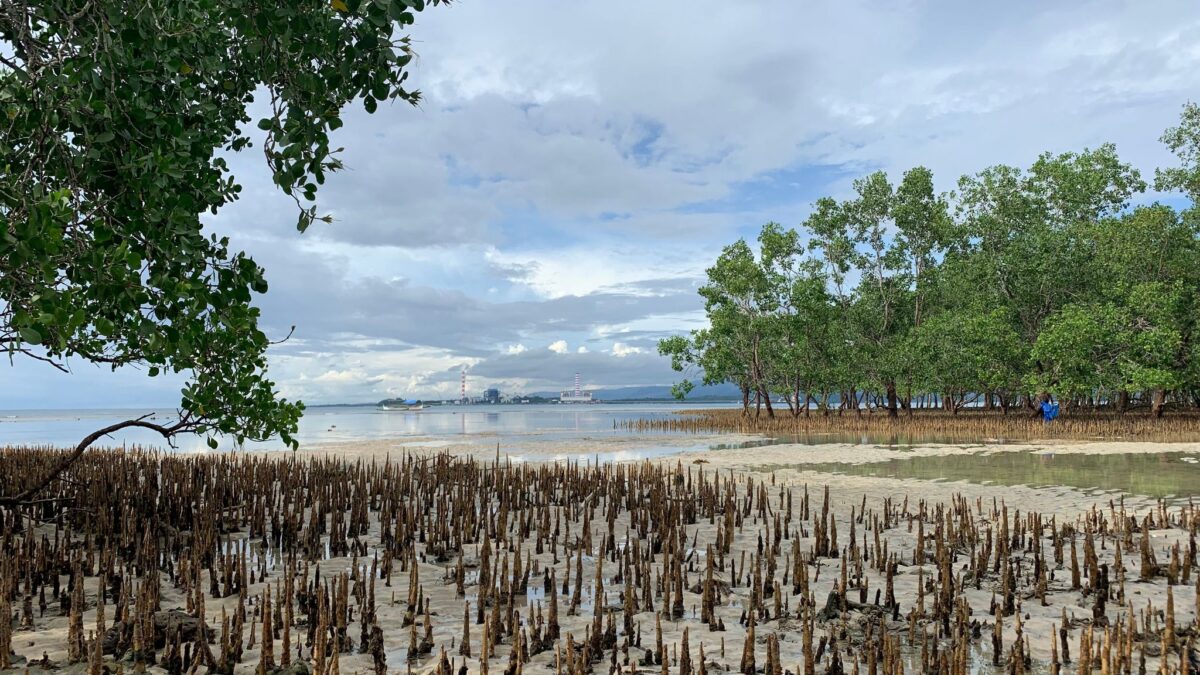Stranded barge threatens fish sanctuary, coral reefs in Zambales

The Masinloc-Oyon Bay Protected Seascape and Landscape, Central Luzon’s first marine protected area and a critical biodiversity site in the Philippines, faces a threat due to the coal from a grounded barge spreading to the waters off Zambales. (Photo by Joanna Rose Aglibot)
MASINLOC, ZAMBALES — Residents near the protected waters of Masinloc-Oyon Bay in this town have expressed alarm after a barge carrying more than 11,000 metric tons of coal ran aground last week, spilling coal into a designated fish sanctuary and potentially damaging the area’s marine ecosystem.
In an interview, Commander Euphraim Jayson Diciano, head of the Philippine Coast Guard (PCG) station in Zambales, said the barge “Katapatan 2” and its tugboat, “Katapatan 1,” departed from Semirara Island, Antique, on Oct. 17 en route to La Union.
But worsening winds and rough seas at the height of Severe Tropical Storm Kristine (international name: Trami) forced them to seek temporary refuge near San Salvador Island on Oct. 24, hoping for a break in the weather.
Diciano said the crew initially intended to take shelter at the Masinloc Power Plant.
Three tugboats from the Masinloc Power Plant arrived to assist the rescue, but one crew member, 40-year-old Benjie Rodriguez, was swept overboard by powerful winds and large waves.
Article continues after this advertisementFellow crew members managed to retrieve Rodriguez, who was unconscious, and rushed him to a nearby hospital, where he was pronounced dead on arrival.
Article continues after this advertisementAs of Oct. 26, the barge remained grounded some 400 meters from the shoreline of San Salvador Island.
Nestor Dait, 67, chairman of the Bantay Dagat (sea patrol) in Masinloc, reported that the barge struck coral reefs, spilling its coal cargo.
“Residents and fellow Bantay Dagat who live near the site say the barge tipped, puncturing its hull in several places, and now it’s completely emptied,” Dait explained.
“It wasn’t the barge’s intention to run aground, but as sea patrols and fishermen, we understand the serious impact coal can have on our fishing grounds and the reefs, which are vital habitats for fish,” he added.
READ: Barge carrying over 11,000 metric tons of coal runs aground in Zambales
Critical biodiversity
Dait is one of the many who have devoted their lives to protecting the Masinloc-Oyon Bay Protected Seascape and Landscape, Central Luzon’s first marine protected area and a critical biodiversity site in the Philippines.
This area, rich in marine life, supports Dait and other fishermen in Masinloc and nearby Palauig, providing a vital source of livelihood.
Leonardo Cuaresma, president of the New Masinloc Fishermen Association, voiced his concern over the potential impact on their fishing grounds, urging authorities to take immediate action.
“It’s already been days since the fishermen couldn’t go out because of the bad weather, and now this—yet another challenge for our fisheries,” Cuaresma said.
He added: “Those who allowed the barge to enter despite the typhoon should be held accountable, especially if there has been damage to the coral reefs.
READ: Inclement weather curbs fish harvests
Accountability
The fisherfolk group Pamalakaya also urged relevant agencies and local governments to act swiftly in removing the stranded barge to prevent the further spread of coal that could damage marine ecosystems.
“The barge’s owner must be held accountable for continuing operations despite the severe weather,” said Ronnel Arambulo, Vice Chairperson of Pamalakaya. “This incident highlights the ongoing use of dirty and unsustainable fuel, which contradicts government statements on prioritizing renewable energy development.”
Diciano said that after receiving Dait’s report, the Masinloc sub-station attempted to deploy their floating asset, but the inclement weather forced them to abort the mission.
“Since the coal is already spreading, it will be a significant challenge for us to contain, as we have limited expertise in managing this situation,” Diciano admitted.
He added: “Unlike oil, which can dissipate or emulsify over time, coal remains a raw product and must be collected manually. But we, together with concerned agencies, are now conducting water testing before we dive to assess the damage in the area.”
Diciano said they were now coordinating with relevant agencies, including the Department of Environment and Natural Resources and the Bureau of Fisheries and Aquatic Resources, to address the situation effectively. INQ